One KHz Order Narrow Linewidth Fiber Laser Using Rayleigh Backscattering Mechanism in an Additional Piece Optical Fiber
Abstract
:1. Introduction
2. Experimental Setup
3. Experimental Results and Discussion
3.1. Determination of EDF and SMF Lengths
3.2. Fiber Laser Shielding
3.3. The Bit Error Rate (BER) Measurement
4. Conclusions
Author Contributions
Funding
Institutional Review Board Statement
Informed Consent Statement
Data Availability Statement
Acknowledgments
Conflicts of Interest
References
- Dai, D.P.; Xia, Y.; Yin, Y.N.; Yang, X.X.; Fang, Y.F.; Li, X.J.; Yin, J.P. A linewidth-narrowed and frequency-stabilized dye laser for application in laser cooling of molecules. Opt. Express 2014, 22, 28645–28652. [Google Scholar] [CrossRef]
- Argence, B.; Chanteau, B.; Lopez, O.; Nicolodi, D.; Abgrall, M.; Chardonnet, C.; Amy-Klein, A. Quantum cascade laser frequency stabilization at the sub-Hz level. Nat. Photonics 2015, 9, 456–460. [Google Scholar] [CrossRef]
- Zhang, L.; Tian, Z.; Chen, N.K.; Han, H.; Liu, C.N.; Grattan, K.T.V.; Rahman, B.M.A.; Liaw, S.K.; Zhou, H.; Bai, C. Room-temperature power-stabilized narrow-linewidth tunable erbium-doped fiber ring laser based on cascaded Mach-Zehnder interferometers with different free spectral range for strain sensing. J. Lightwave Technol. 2020, 38, 1966–1974. [Google Scholar] [CrossRef]
- Lee, H.-C.; Lee, Y.-W.; Chang, J.-S.; Liaw, S.-K. Single-Frequency Fiber Laser Implementation by Using Only Two Subring-Cavity in Serial/Parallel Connection. Fiber Integr. Opt. 2019, 38, 236–246. [Google Scholar] [CrossRef]
- Bayer, M.M.; Li, X.; Guentchev, G.N.; Torun, R.; Velazco, J.E.; Boyraz, O. Single-shot ranging and velocimetry with a CW lidar far beyond the coherence length of the CW laser. Opt. Express 2021, 29, 42343–42354. [Google Scholar] [CrossRef]
- Baharmast, A.; Kurtti, S.; Kostamovaara, J. A wide dynamic range laser radar receiver based on input pulse-shaping techniques. IEEE Trans. Circuits Syst. I Regul. Pap. 2020, 67, 2566–2577. [Google Scholar] [CrossRef]
- O’Carroll, J.; Phelan, R.; Kelly, B.; Huynh, T.N.; Cardiff, B.; Smyth, F.; Barry, L.P. Narrow-linewidth discrete-mode laser diodes for coherent communication applications. IEEE/OSA J. Opt. Commun. Netw. 2012, 4, A90–A96. [Google Scholar] [CrossRef]
- Kita, T.; Tang, R.; Yamada, H. Narrow spectral linewidth silicon photonic wavelength tunable laser diode for digital coherent communication system. IEEE J. Sel. Top. Quantum Electron. 2020, 22, 2566–2577. [Google Scholar] [CrossRef]
- Zhu, T.; He, Q.; Xiao, X.; Bao, X. Modulated pulses based distributed vibration sensing with a high-frequency response and spatial resolution. Opt. Express 2013, 21, 2953–2963. [Google Scholar] [CrossRef]
- Valle, A.; Quirce, A.; Ji, S.K.; Hong, Y.H. Polarization effects on photonic microwave generation in vcsels under optical injection. IEEE Photonics Technol. Lett. 2018, 30, 1266–1269. [Google Scholar] [CrossRef] [Green Version]
- Pixley, N.C.; Correll, T.L.; Pappas, D.; Matveev, O.I.; Smith, B.W.; Winefordner, J.D. Tunable resonance fluorescence monochromator with the sub-Doppler spectral resolution. Opt. Lett. 2001, 26, 1946–1948. [Google Scholar] [CrossRef] [PubMed]
- Zhou, K.; Zhao, Q.L.; Huang, X.; Yang, C.S.; Li, C.; Zhou, E.; Xu, X.G.; Wong, K.K.Y.; Cheng, H.; Gan, J.L.; et al. kHz-order linewidth controllable 1550 nm single-frequency fiber laser for coherent optical communication. Opt. Express 2017, 25, 19752–19759. [Google Scholar] [CrossRef]
- Xu, S.H.; Yang, Z.M.; Liu, T.; Zhang, W.N.; Feng, Z.M.; Zhang, Q.Y.; Jiang, Z.H. An efficient compact 300 mW narrow-linewidth single frequency fiber laser at 1.5 μm. Opt. Express 2010, 18, 1249–1254. [Google Scholar] [CrossRef]
- Yu, L.; Lu, D.; Pan, B.; Zhang, L.; Guo, L.; Li, Z.; Zhao, L.J. Widely tunable narrow-linewidth lasers using self-injection DBR lasers. IEEE Photonics Technol. Lett. 2015, 27, 50–53. [Google Scholar] [CrossRef]
- Ou, Z.; Bao, X.; Li, Y.; Saxena, B.; Chen, L. Ultranarrow linewidth Brillouin fiber laser. IEEE Photonics Technol. Lett. 2014, 26, 2058–2061. [Google Scholar] [CrossRef]
- Yao, S.; Yang, Y.; Shen, Y.; Han, W.; Jiang, Y.; Jian, S. All-fiber single-longitudinal-mode narrow linewidth fiber ring laser with cylindrical vector beam output. Laser Phys. Lett. 2018, 15, 115107. [Google Scholar] [CrossRef]
- Fu, P.; Feng, X.Q.; Lu, B.; Qi, X.Y.; Chen, H.; Sun, B.; Jiang, M.; Wang, K.; Bai, J. Switchable dual-wavelength SLM narrow linewidth fiber laser based on nonlinear amplifying loop mirror. Opt. Laser Technol. 2018, 98, 56–60. [Google Scholar] [CrossRef]
- Wang, Z.; Shang, J.; Li, S.; Mu, K.; Qiao, Y.; Yu, S. All-polarization maintaining single-longitudinal-mode fiber laser with ultra-high OSNR, sub-KHz linewidth and extremely high stability. Opt. Laser Technol. 2021, 141, 107135. [Google Scholar] [CrossRef]
- Huang, L.; Yang, C.; Tan, T.; Lin, W.; Zhang, Z.; Zhou, K.; Zhao, Q.; Teng, X.; Xu, S.; Yang, Z. Sub-kHz-linewidth wavelength-tunable single-frequency ring-cavity fiber laser for C- and L-band operation. Opt. Laser Technol. 2021, 39, 4794–4799. [Google Scholar] [CrossRef]
- Ali, A.H.; Abdul-Wahid, S.N. Analysis of self-homodyne and delayed self-heterodyne detections for tunable laser source linewidth measurements. IOSR J. Eng. 2012, 2, 1–6. [Google Scholar]
- Wang, Z.; Ke, C.; Zhong, Y.; Xing, C.; Wang, H.; Yang, K.; Cui, S.; Liu, D. Ultra-narrow-linewidth measurement utilizing dual-parameter acquisition through a partially coherent light interference. Opt. Express 2020, 28, 8484–8493. [Google Scholar] [CrossRef] [PubMed]
- Huang, S.; Zhu, T.; Liu, M.; Huang, W. Precise measurement of ultra-narrow laser linewidths using the strong coherent envelope. Sci. Rep. 2017, 7, 41988. [Google Scholar] [CrossRef] [PubMed] [Green Version]
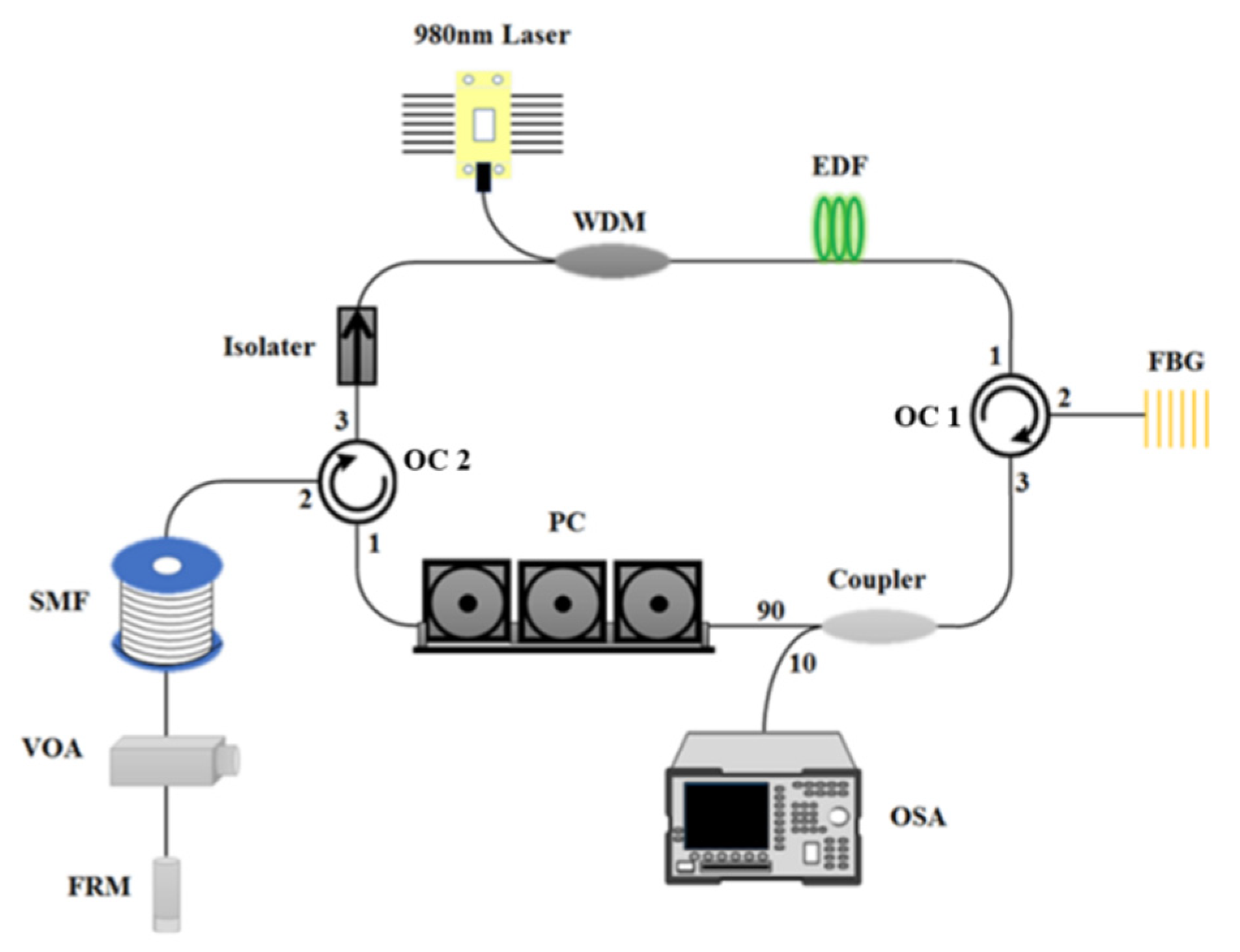
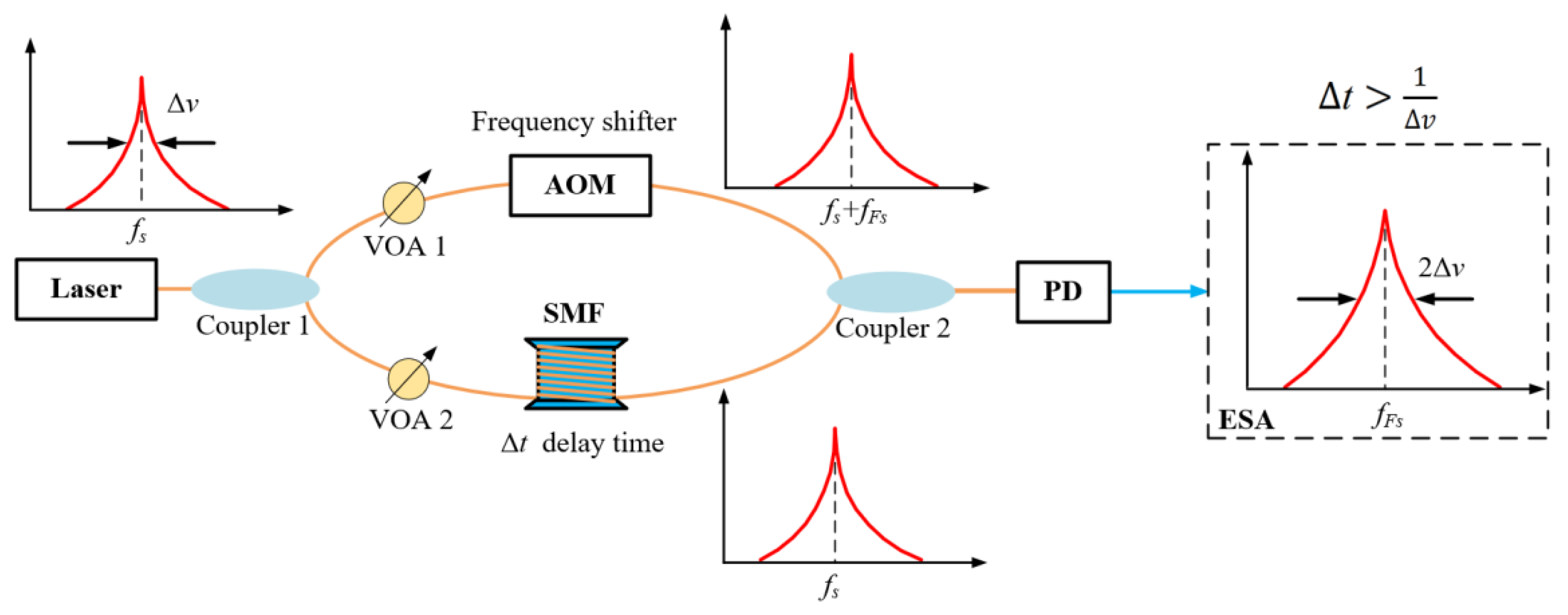
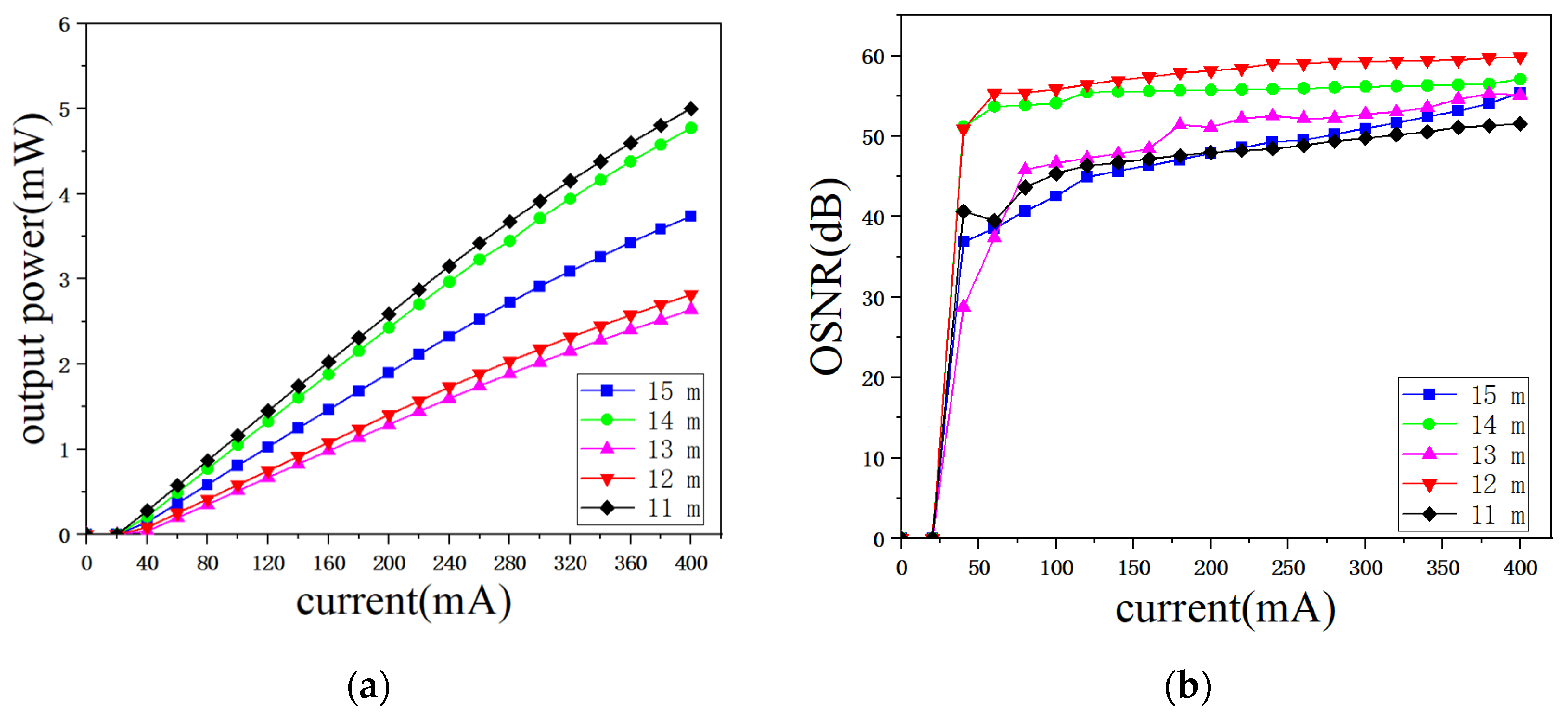
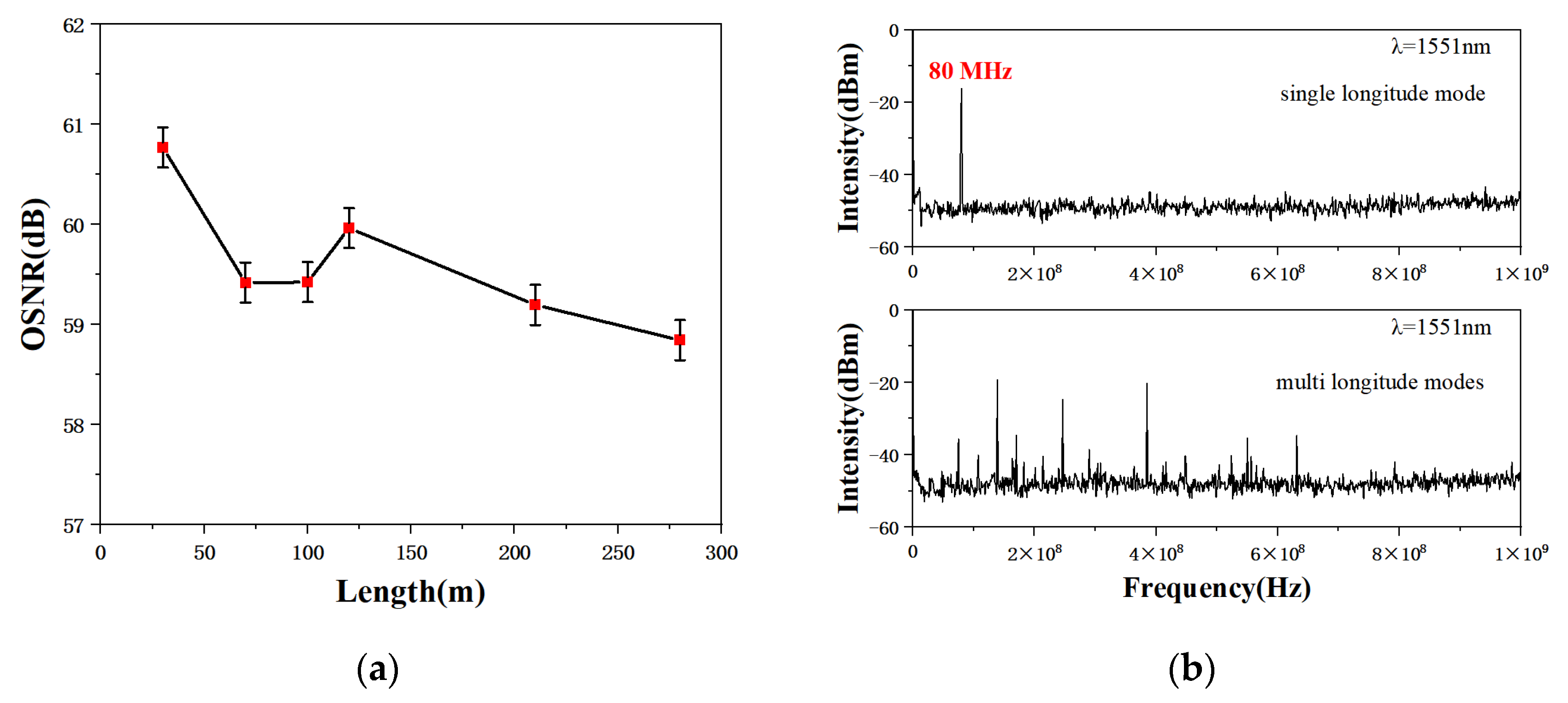

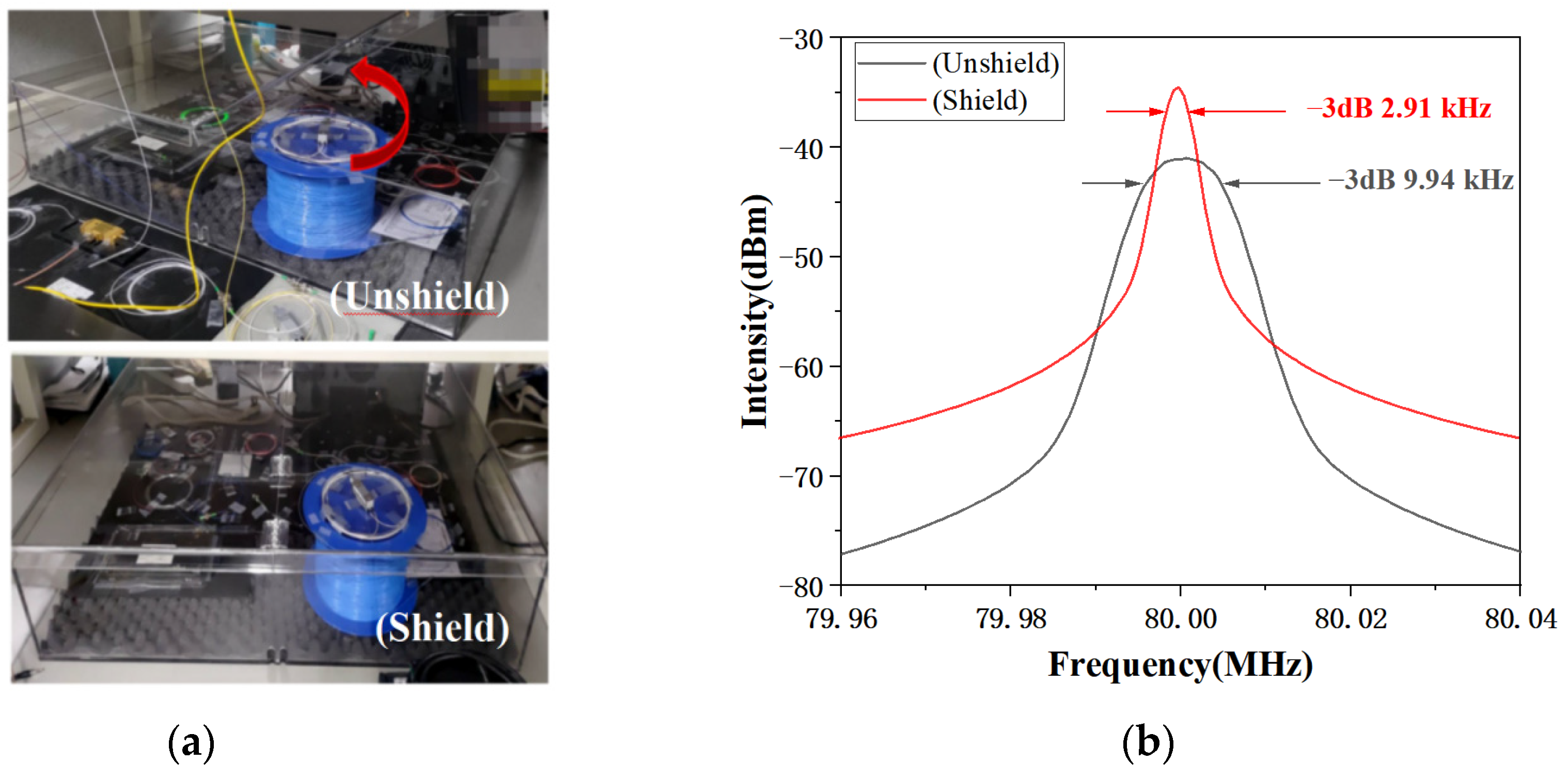

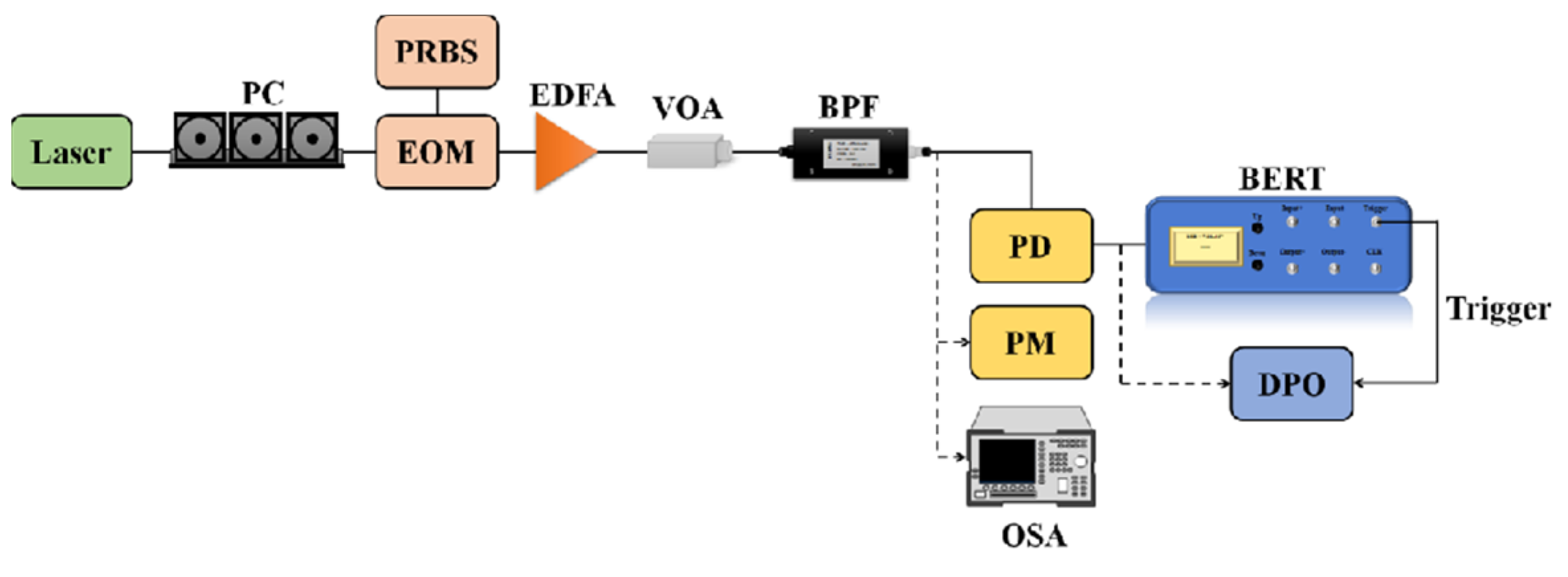

Publisher’s Note: MDPI stays neutral with regard to jurisdictional claims in published maps and institutional affiliations. |
© 2022 by the authors. Licensee MDPI, Basel, Switzerland. This article is an open access article distributed under the terms and conditions of the Creative Commons Attribution (CC BY) license (https://creativecommons.org/licenses/by/4.0/).
Share and Cite
Wang, Z.; Li, D.-C.; Chen, G.-Y.; Wang, L.-E.; Liaw, S.-K.; Yeh, C.-H.; Yu, Y.-L.; Tsai, H.-H. One KHz Order Narrow Linewidth Fiber Laser Using Rayleigh Backscattering Mechanism in an Additional Piece Optical Fiber. Photonics 2022, 9, 601. https://doi.org/10.3390/photonics9090601
Wang Z, Li D-C, Chen G-Y, Wang L-E, Liaw S-K, Yeh C-H, Yu Y-L, Tsai H-H. One KHz Order Narrow Linewidth Fiber Laser Using Rayleigh Backscattering Mechanism in an Additional Piece Optical Fiber. Photonics. 2022; 9(9):601. https://doi.org/10.3390/photonics9090601
Chicago/Turabian StyleWang, Zi, Dong-Chang Li, Geng-Ying Chen, Li-En Wang, Shien-Kuei Liaw, Chien-Hung Yeh, Yi-Lin Yu, and Hsiou-Hsin Tsai. 2022. "One KHz Order Narrow Linewidth Fiber Laser Using Rayleigh Backscattering Mechanism in an Additional Piece Optical Fiber" Photonics 9, no. 9: 601. https://doi.org/10.3390/photonics9090601
APA StyleWang, Z., Li, D.-C., Chen, G.-Y., Wang, L.-E., Liaw, S.-K., Yeh, C.-H., Yu, Y.-L., & Tsai, H.-H. (2022). One KHz Order Narrow Linewidth Fiber Laser Using Rayleigh Backscattering Mechanism in an Additional Piece Optical Fiber. Photonics, 9(9), 601. https://doi.org/10.3390/photonics9090601






